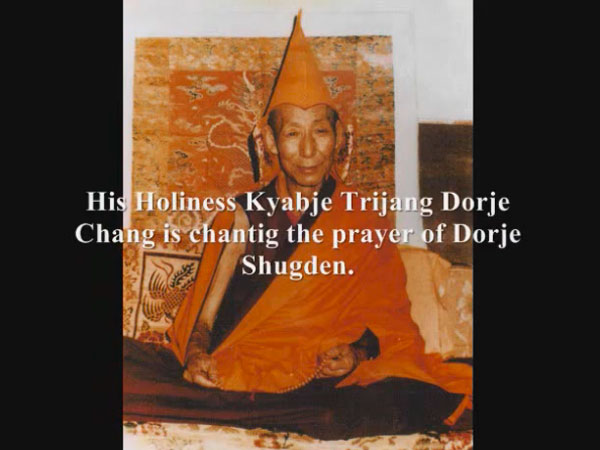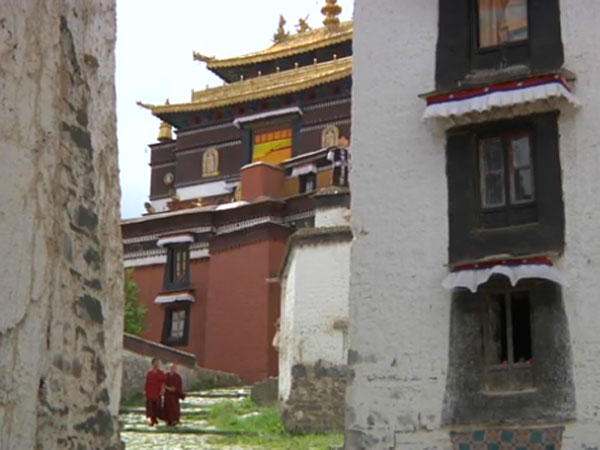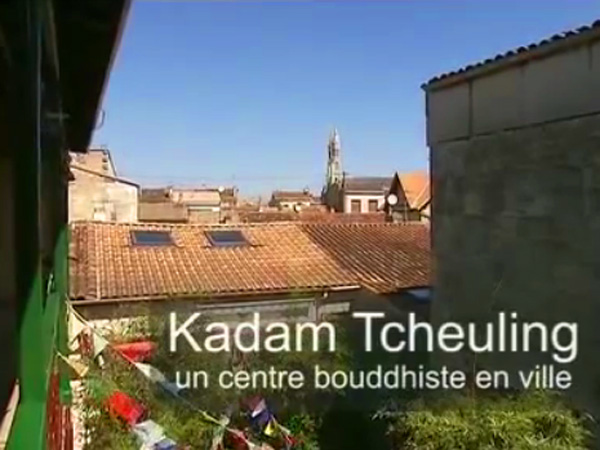DHARMA READINGS
| A TEACHING ON DHARMAPALAS FROM A KAGYU PERSPECTIVE | | Print | |
Page 1 of 2  By Choje Lama Namse Rinpoche Lama Namse Rinpoche was born in Tsurphu, Tibet in 1930 and became a monk at the age of 15. He studied the Tibetan religious language, etymology, grammar, poetry, all major Hinayana and Mahayana texts and commentaries, as well as the philosophy of the various Buddhist schools from ages 16 to 21. Then Lama Namse did a three-year, three-month, three-day retreat and practiced the profound instructions of the Kagyu teachings intensively. Readers' Comments
From 24 to 26, he concentrated on The Five Treasuries of Jamgon Kongtrul the Great. From 27 to 30, Lama Namse went on pilgrimage and practiced in many sacred retreat sites. He left Tibet and came to India when he was 30 and did another three-year retreat. Then he became a retreat master for many new retreatants. He travelled to Rumtek Dharmachakra Centre when he was 37 and received the empowerments of the Kagyu Ngagzod and Damgang Ngagzod. Since 1974, he has served as a teacher of the Kagyu Lineage all over Europe and has helped many students understand the path. Lama Namse Rinpoche is His Holiness Karmapa's official representative in Canada and is head of Karma Sonam Dargye Ling, the Canadian centre for His Holiness the 17th Gyalwa Karmapa, Ogyen Trinley Dorje. When receiving precious Dharma instructions, especially those of the Great Vehicle, it is necessary to arouse the pure motivation, Bodhicitta, which is the sincere wish to attain a enlightened mind for the benefit of oneself and every living being. Before earnestly studying and meditating the Buddhadharma, it is utterly necessary to recollect the fundamental teachings and to be sure that one has understood them correctly. Every Dharma activity presupposes a good understanding of the basic instructions that Lord Buddha gave to us. For example, any skyscraper that is erected without a fundament will collapse in a storm. It is the same with knowledge of Dharma: It is only possible to progress in one's practice if one understands and has integrated the basic instructions in one's life. It is tempting to think one has understood them, but it happens so very often that practitioners falter if they skip stages while hoping to traverse the path and achieve fruition. I was asked to speak about the practice of Mahakala, but there must be a misunderstanding. In order to meditate Mahakala, a disciple must have completed Ngondro (the preliminary practices) and a yidam practice. This is the reason why instructions on Mahakala are not presented to a general audience nor in public - it is not common and would not benefit anyone.  Western students are fascinated about the idea of meditating on Mahakala, but it is only correct to present the instructions to advanced practitioners. If a student meditates on similar practices without having completed the preliminary and yidam practices, then there is the very great danger and probability that many false concepts will arise and as a result that person will err, which would be extremely difficult to heal. Without the fundamental practices, one cannot understand Mahakala. It is better to refrain, seeing that practicing Mahakala without preparations on the part of a disciple only makes him or her more neurotic and confused. Furthermore, receiving the empowerment that allows one to practice Mahakala involves profound details and a strict commitment. Living up to the commitment of engaging in the quite complex details of practice that the empowerment entails can become more than difficult for you. I do not want to withhold anything from you, rather I want to protect you from making a promise that you cannot keep. But I will offer the blessing. Let me explain this with an example: People in the West need to have completed elementary school, then junior high, and later received a high school education before going to college. No parent would think of registering a six-year old child at a university. Wouldn't a youngster be out of place and suffer frustrating consequences if parents overloaded their child with such high expectations should that child be enrolled in university courses? Dharma is the same it is necessary to first fully understand what one is doing. Intellectually reiterating what one has heard will not do. Disciples need to discuss their practice with their teacher. If a meditation master sees that a disciple is ready, then he will suggest which practice is suitable and best. Students must rely upon the insight and decision an authentic and qualified instructor makes when it comes to Dharmapala1 meditation. It is necessary to follow the path properly if one wishes to integrate the Dharma in one's life. It is of no help at all to skip stages, because something will be missing along the way; sooner or later one will have difficulties, because one would not know how to differentiate mistaken ideas that are so hard to correct. Therefore, it is absolutely necessary to practice step-by-step and in accordance with an authorized Lama's instructions. It is also important to do the practice that he recommends in order to benefit reliably. There are different types of Dharmapalas - male and female, with one or two faces, with two or many arms, and in powerful and ferocious forms that bewilder and frighten those who arent initiated but see them. So, if a student isn't ready but meditates on a Dharmapala, there is the great danger that he or she might think it is all right to destroy enemies or carry out harmful activities with the same force as a specific Protector. This problem is not new; it occurred in Tibet for hundreds of years - there are always people who misuse these most peaceful yet powerful techniques of practice. Misled individuals might accomplish their malicious aims by relying on Dharmapalas. One thing for sure, though, meditating upon a Dharmapala with the wrong intention and understanding will directly lead to rebirth in a lower realm of existence, horrendous states in which beings are doomed to suffer extreme anguish and pain for a very long period of time. In that case, the favourable freedoms and advantages that we all have got now and that are so hard to get - a precious human birth - will have been totally wasted.  It is generally said that the task of a Dharmapala is to protect the doctrine, its upholders, and practitioners. It is not that easy for lay practitioners to appreciate the various Dharmapalas, though. Mahakala, for instance, is depicted stomping on two human beings, who symbolize death of the two main obscurations that, like a corpse, will not stand up again. Hagiographies of great realized masters tell us that they recited millions of mantras of Chakrasamvara or Hevajra, for instance, before they concentrated on a guardian deity. These practices must be perfectly accomplished before one even hopes to meditate on a Dharmapala correctly. It is of utmost importance to be very cautious, to be honest with oneself, and to be concise. There are three kinds of Protectors: wisdom, activity, and worldly protectors. A few wisdom protectors are indivisibly united with Avalokiteshvara, Chenrezig, the Lord of Compassion. Other wisdom protectors emanate directly. They are completely enlightened Bodhisattvas who have taken the vow to guard wisdom-holders and the Buddhadharma for the benefit of sentient beings. When reciting the Refuge Prayer in Ngondro, we seek refuge in the Dharma Protectors who are wise and who do not harm a single being, not even in slightest ways. Practitioners must be careful about the larger number of worldly protectors. There are more worldly protectors than wisdom Dharmapalas. Worldly protectors still have subtle veils. They can be compared with human beings like us, who are apt to do good but do bad things too, and they do cause problems. We can compare worldly protectors with someone who blackmails us or expects a lot in return for any help they may give. We are bound once we have such an unfortunate relationship, because they demand regular offerings from us - if we fail, were in for a surprise. There are protectors even more mundane than the worldly protectors; they control the worldly protectors. If these mundane beings become upset because we didnt satisfy them in one way or another, then trouble is in store, for example, mental and physical illnesses. It is extremely hard to please such beings; they become very nasty if they dont like something we did or failed to do for them. There are wisdom Dharmapalas who protect a lineage; for example, the six-armed Mahakala is the guardian of our Kagyu Lineage. The two-armed Mahakala is not the main Protector of the Kagyu Lineage, rather specifically a Protector of the Karmapas. Wisdom Dharmapalas are emanations of Bodhisattvas like Avalokiteshvara. It is said that he once saw that it was necessary to emanate a wrathful form. Light flowed from the dark blue syllable HUNG in his heart and spontaneously became a Protector that was perceived in such a form. Avalokiteshvara did emanate for specific purposes - to give advanced masters powerful practices that enable them to pacify severe situations with wisdom and compassion and to continuously benefit beings through the unimpeded play of the enlightened mind. Even though a Dharmapala is an emanation of Avalokiteshvara, it is not possible for ordinary practitioners to deal with him adequately, and therefore I want to warn you to please not even think about meditating on a Dharmapala at this stage in your practice. Most Dharmapala practices belong to the Secret Mantrayana, which is synonymous with Vajrayana. It is important to understand what is meant by 'secret'. The term 'secret' that is used in association with higher tantras is not something like a secret military force that an evil opponent may not discover, rather it means that the instructions are only given to disciples if they are useful to them and if they can practice without taking or causing harm. If a disciple has not met preparations and is not ready, then it would be too early and even dangerous - therefore wrong - to impart the instructions, since a disciple could have mistaken thoughts and distorted ideas about them. For instance, a misled disciple might think Dharmapalas are malevolent spirits who are about to attack - one of the dangers that the Secret Mantrayana brings along. Therefore, it is said that if one wants to embark on the vehicle of Mantrayana, it is absolutely necessary to rely on a Lama and to practice the instructions that he imparts. Sincere trust and devotion in a root Lama enable a follower to traverse Vajrayana correctly, to practice the profound techniques, and attain fruition very fast. If a Lama sees that further deep instructions cannot benefit a disciple, they are kept secret2. There is a reason why there are three vehicles in Buddhism; they are differentiated according to the time it takes for a diligent follower to achieve fruition. Hinayana practitioners need many eons to accumulate merit, to eliminate negative habits, and to engage in beneficial activities. Mahayana practitioners advance faster, but they need many lives to attain fruition. Vajrayana practitioners can attain Buddhahood within one single life, but they need unwavering trust and devotion; they did meet preparations in former lives to understand the teachings correctly now and to have the opportunity to practice them diligently in this life. Lord Buddha did not teach Vajrayana in public. It is recorded in the tantras that the Buddha did not appear in his usual form when he taught Vajrayana, rather he manifested as the deity of a specific tantra when he spoke to those few individuals in India who were ready to receive the quite profound teachings. When the great councils were convened many years after the Buddhas Parinirvana, nobody knew what Vajrayana followers were doing; they did not speak about this openly. Noble followers of Vajrayana did not talk about their practices with anyone except their personal meditation master, their root Guru, which enabled them to mature and advance quickly and efficiently. This very silent approach changed when the Dharma was brought to Tibet and Vajrayana became the spiritual reference for an entire nation of citizens. Of course, Vajrayana spread like wildfire in Tibet, but after it became institutionalized, the number of great practitioners who attained realization rapidly declined.
|
Comments
OTHER DHARMA READINGS
- A GUIDE TO SPIRITUAL PRACTICE
- DHARMA DEMYSTIFIED: NAGARJUNA, THE FOUNDER OF THE MAHAYANA TRADITION
- DORJE SHUGDEN ON BLACK HORSE
- WHY MANJUSHRI MATTERS
- DHARMA DEMYSTIFIED: THE ENTHRONEMENT OF DORJE SHUGDEN









